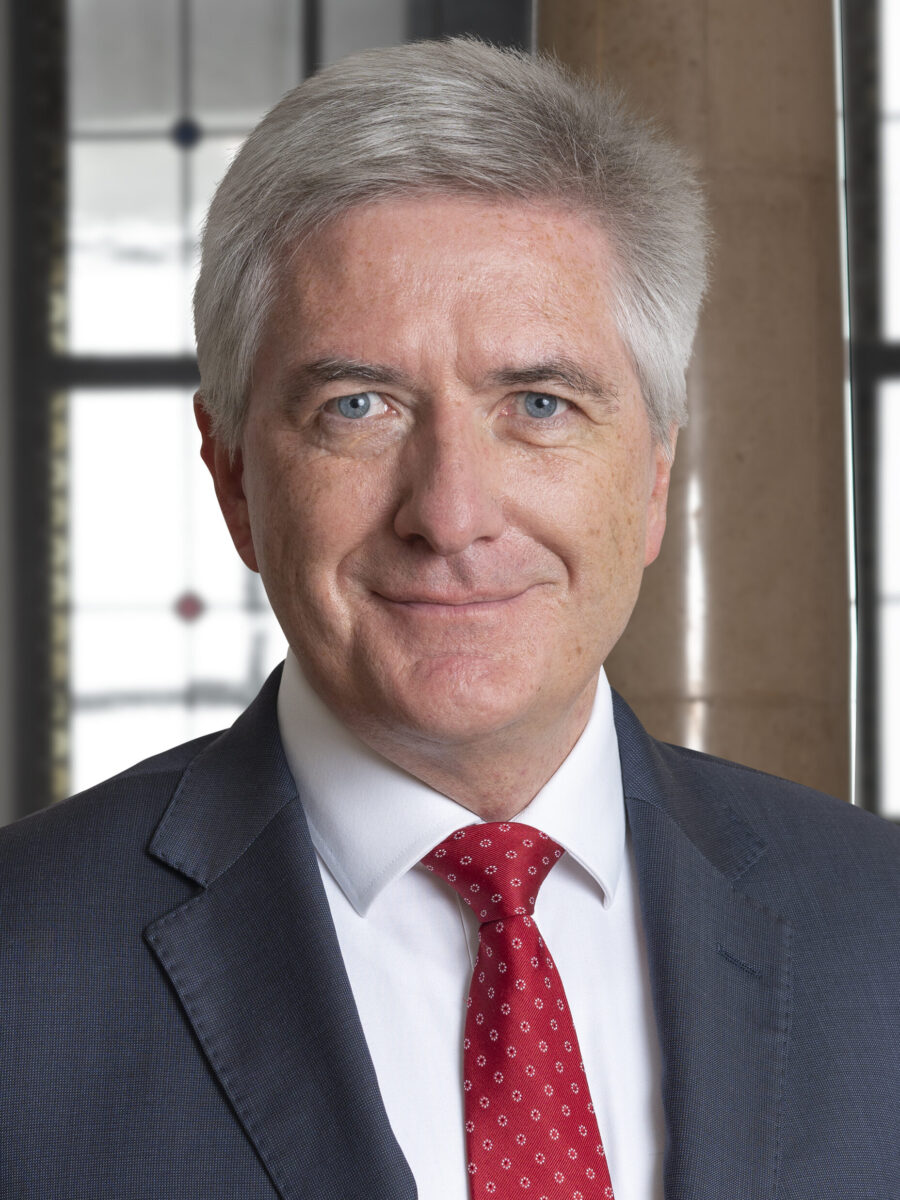
Prof Meyer, you are Chief Investment Strategist and Head of Multi Asset in Wealth & Asset Management. A year ago, you predicted that 2023 would be "better, but not easier" for investors. Has that turned out to be true?
In 2022, there were broad losses across almost all asset classes. Only commodities performed well. Equities and bonds lost in tandem. This was due to a general reduction in valuations driven by a sharp rise in real yields – the real yield on 10-year inflation-indexed US bonds rose by 2.5 percentage points. A further rise of a similar magnitude was very unlikely. In addition, the valuations of equities and bonds had already become significantly more attractive. This also proved true in 2023. Equities made up some of the losses from 2022 and bonds also performed positively across almost all segments. Therefore, 2023 was indeed a better year, albeit not an easier one for investors.
What made 2023 so difficult for investors?
There were many surprises in 2023 compared to consensus expectations. At the end of 2022, the expectation was that the US economy would stagnate in early 2023 as a result of the tighter monetary policy and then fall into a mild recession by autumn 2023, allowing the Fed to cut interest rates again from the second half of the year. In Europe, a recession already appeared to be on the horizon, which would last throughout the winter due to high energy prices. In China, the easing of the rigid zero-covid policy was expected to lead to a stabilisation and recovery of the economy. In the end, however, everything turned out differently.
Europe came through the winter much better than expected but slipped into recession in the second half of the year. The recovery in China was short-lived and the US economy proved to be surprisingly robust – despite the banking crisis in the spring. US economic data has continuously surprised on the upside throughout the year. As a result, there were further interest rate increases in the second half of the year instead of the first interest rate cuts. Monetary policy became significantly more restrictive than expected and bond yields continued to rise, also favoured by rising US government debt. The real yield on 10-year inflation-linked bonds climbed by a further percentage point in the third quarter. Similar to 2022, equities and bonds then fell again in tandem. Investments with high interest rate sensitivity, such as growth and second-line stocks, suffered in particular. To a certain extent, the markets experienced a continuation of the perfect storm of 2022. It was not until November that a countermovement set in with weaker US economic data. The dominant theme on the market was therefore constantly changing and bond yields fluctuated wildly. This was exacerbated by the fact that in the US, the topic of artificial intelligence boosted individual large technology stocks despite rising interest rates, while the rest of the market treaded water. The low market breadth and the strong outperformance of the so-called "Magnificent 7" was a decisive feature in 2023. And finally, the Israel-Hamas conflict added another geopolitical risk.
What have there developments meant for mulit-asset stretegies? What adjustments have you made over the course of the year?
Like the markets, our strategies developed positively. Nevertheless, after the painful year of 2022, the performance of our strategies in 2023 was unable to match the pleasing results of previous years. The negative impact came from three fronts: broad diversification, cautious positioning from March onwards and stock selection.
We had correctly anticipated the bottoming out of equities in the second half of 2022 and started 2023 with considerable momentum from autumn 2022. However, after the significant recovery up to February and with the US regional banking crisis and the continued restrictive monetary policy, the risks increased and we positioned ourselves more defensively and more broadly again. That was too early. We hardly benefited from the performance of US equities in the wake of the AI euphoria until the end of July due to our US underweighting in view of the still high valuations of US equities. By contrast, other investments have barely risen or have fallen. The lack of a significant recovery in China weighed on the direct and indirect China exposure in our portfolios. Commodities only rose in the second half of the year. Although diversification was justified in an environment of heightened risks, it did not pay off in the first half of the year, nor did our significant addition of second-line stocks. In addition, the tailhedge certificate used in many of our strategies fell in an environment of rising equity markets and declining volatility.
From July to October, a significant admixture of commodities was beneficial, and our scepticism towards the overall market trend also paid off – European equities fell well below the levels of February, while American equities fell back to February levels. However, the further rise in US real yields to 2.5% once again weighed on the quality and growth stocks and small caps that Berenberg focuses on. In addition, there were some disappointing developments in the selected individual stocks. Our duration management for bonds was more positive. With interest rates continuing to rise, we were short here for a long time due to the high interest rate volatility and the greater synchronisation of equities and bonds. It was not until the end of the third quarter that we raised the duration to neutral, which proved to be a good move from November onwards. After the equity markets had corrected by more than 10% from July to the end of October, we raised our equity weighting to just a small underweight at the end of October. Since November, we have been able to make up some ground on the benchmark.
In which scenarios are your multi-asset strategies likely to outperform in the coming months?
If the rising interest rate environment of the last two years continues, which we believe is unlikely, our strategies will not have an easy time, but they will underperform significantly less. The valuation correction in quality-growth equities should be largely behind us and carry in bonds should (partially) compensate for any further rise in interest rates. However, if interest rates stabilise or fall, our strategies are likely to outperform due to our high bond and gold exposure and our equity style (focus on growth and quality stocks as well as small caps). In a scenario in which the equity markets would fall due to a stronger economic downturn, our cautious positioning and diversification should help to ensure that our strategies only lose less than average. If markets move sideways, our strategies should perform well thanks to the high current yield at portfolio level. We also expect China to continue to recover over time. Then, our strategies should benefit from their indirect China investments (industrial metals, etc.).
How do you generally assess the environment for mulit-asset strategies – especially in a world with positive bond yields?
In my view, the starting point for "true" multi-asset strategies is very good. Bonds have become an attractive asset class again thanks to the significant rise in yields. Apart from the major AI beneficiaries, equities have undergone a significant valuation correction, especially small caps and many quality stocks. Commodities are structurally supported by the energy transition, deglobalisation and rearmament, with far too little investment in production capacities in recent years. The yield expectations for the various asset classes are closer together than they have been for a long time, meaning that broad diversification should not be associated with yield disadvantages. Higher inflation and, in particular, inflation volatility in the medium term and thus a higher correlation between equities and bonds also argues in favour of broad diversification across all asset classes, segments and regions. In contrast to investments in short-dated safe bonds or time deposits, such a structure should generate a return over the next 5-10 years that is above inflation and thus not only enable the real preservation of assets, but also their growth. Multi-asset approaches that rely heavily on investments with a tangible asset character (commodities, equities) offer clear advantages over purely nominal financial investments, not only in the event of surprising inflation, but also in view of the risks posed by rising global sovereign debt.
Our interview guest

Prof. Dr. Bernd Meyer
Prof. Dr. Bernd Meyer has been Chief Investment Strategist at Berenberg Wealth and Asset Management since October 2017, where he is responsible for discretionary multi-asset strategies and wealth management mandates. Prof. Dr. Meyer was initially Head of European Equity Strategy at Deutsche Bank in Frankfurt and London and, from 2010, Head of Global Cross Asset Strategy Research at Commerzbank. In this role Prof. Dr. Meyer has received several awards. In the renowned Extel Survey from 2013 to 2017, he and his team ranked among the top three multi-asset research teams worldwide. Prof. Dr. Meyer is DVFA Investment Analyst, Chartered Financial Analyst (CFA) and guest lecturer for "Empirical Research in Finance" at the University of Trier. He has published numerous articles and two books and received three scientific awards.



